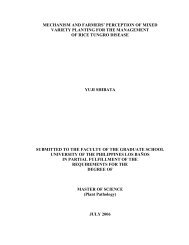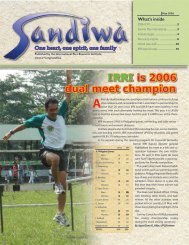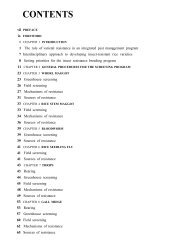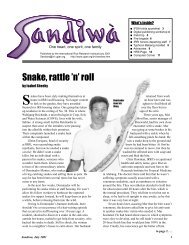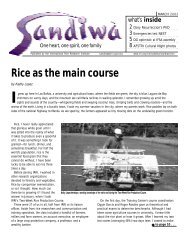Untitled - International Rice Research Institute
Untitled - International Rice Research Institute
Untitled - International Rice Research Institute
You also want an ePaper? Increase the reach of your titles
YUMPU automatically turns print PDFs into web optimized ePapers that Google loves.
Microdochium oryzae (Hashioka & Yokogi) Samuels & Hallett<br />
syn. Gerlachia oryzae (Hashioka & Yokogi) W. Gams.<br />
Rhychosporium oryzae Hashioka & Yokogi<br />
teleomorph: Monographella albescens (Thumen) Parkinson, Sivanesan & C. Booth<br />
syn. Metasphaeria albescens Thum.<br />
Metasphaeria oryzae-sativae Hara<br />
Micronectriella pavgii R.A. Singh<br />
Griposphaerella albescens (Thumen) Von Arx<br />
Disease caused: leaf scald<br />
a. Symptoms<br />
Lesions are usually observed on mature leaves.<br />
Characteristic symptoms include zonated lesions<br />
that start at leaf edges or tips. The lesion shape is<br />
more or less oblong with light brown halos measuring<br />
1–5 cm long and 0.5–1 cm wide. Individual<br />
lesions enlarge and eventually coalesce. As lesions<br />
become old, zonations fade.<br />
b. Occurrence/distribution<br />
Leaf scald has been reported in all rice-growing<br />
countries worldwide (Fig. 18).<br />
c. Disease history<br />
Leaf scald was first reported in 1955 in Japan,<br />
and the causal organism was named as<br />
Rhynchosporium oryzae. However, the disease<br />
was known under different names. The causal<br />
fungus was confused with Fusarium nivale as the<br />
anamorph and with Micronectriella nivalis as the<br />
teleomorph. Later it was proved that the leaf scald<br />
fungus is not F. nivale. The anamorph and<br />
teleomorph of the leaf scald fungus have undergone<br />
many changes and are now known as<br />
Gerlachia oryzae and Monographella albescens,<br />
respectively.<br />
d. Importance in crop production<br />
Leaf scald is very common on rice in tropical<br />
Asia. It is considered a relatively minor problem<br />
causing little yield loss alone in rice production.<br />
Detection on seed<br />
a. Incubation period on blotter<br />
Using the blotter test, M. oryzae can be observed<br />
on rice seeds 7 d after seeding and incubation<br />
under NUV light at 21 °C. The detection frequency<br />
is about 28.2% on seeds coming from<br />
different regions (Fig. 19a,b).<br />
b. Habit character<br />
Aerial mycelia are absent; light pinkish or light<br />
orange to bright orange irregular masses<br />
Fig. 18. Occurrence of leaf scald (Ou 1985, Agarwal and Mathur 1988).<br />
24



